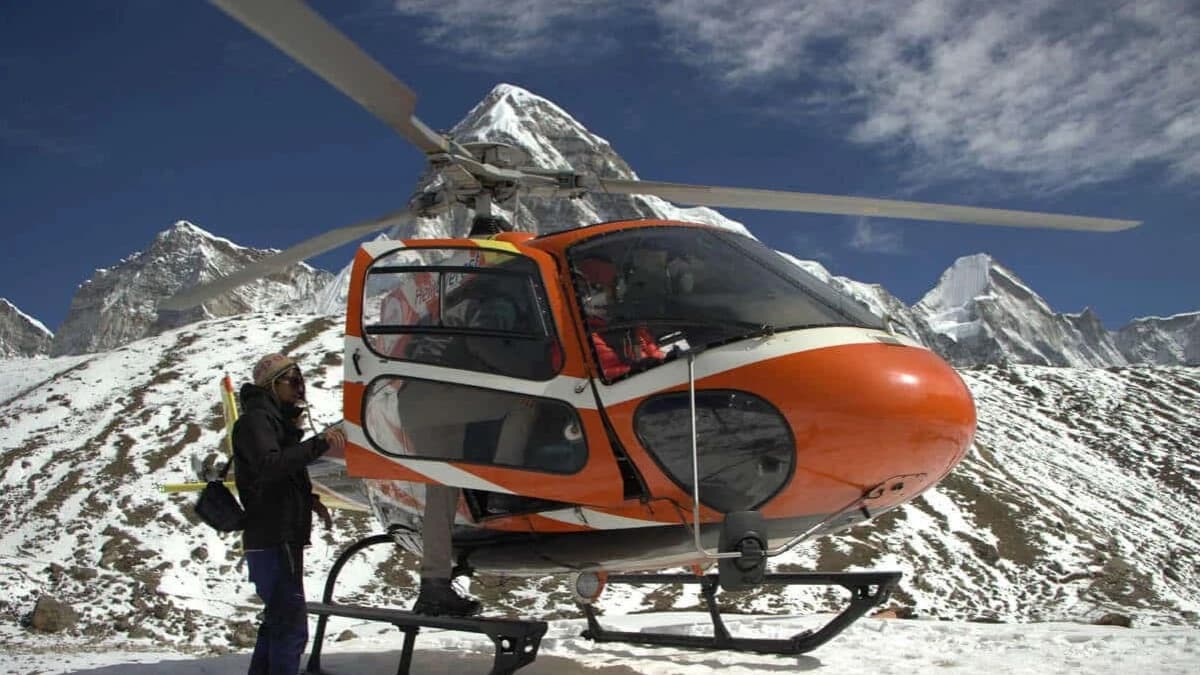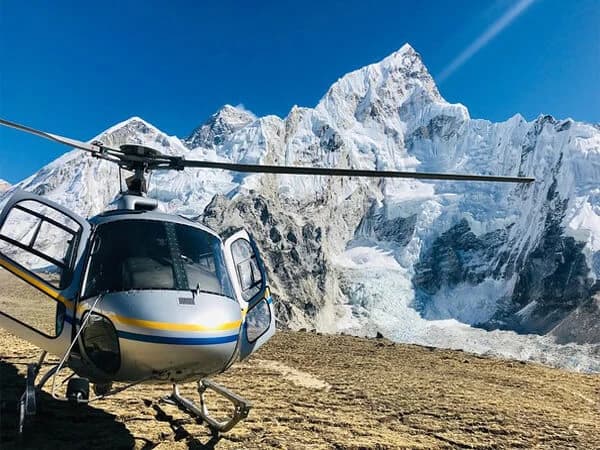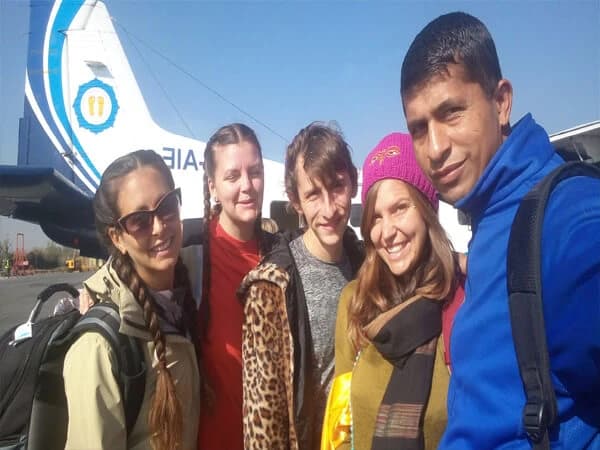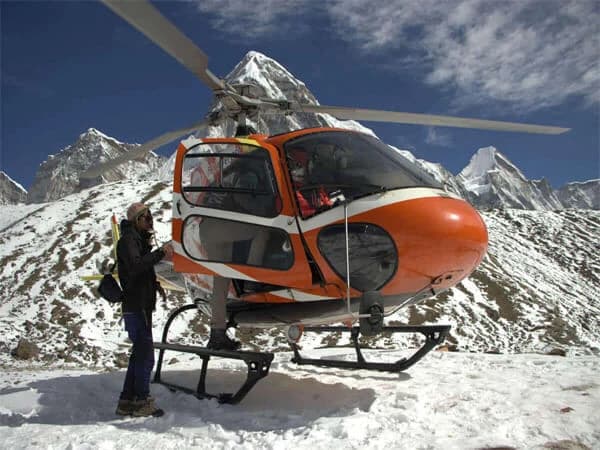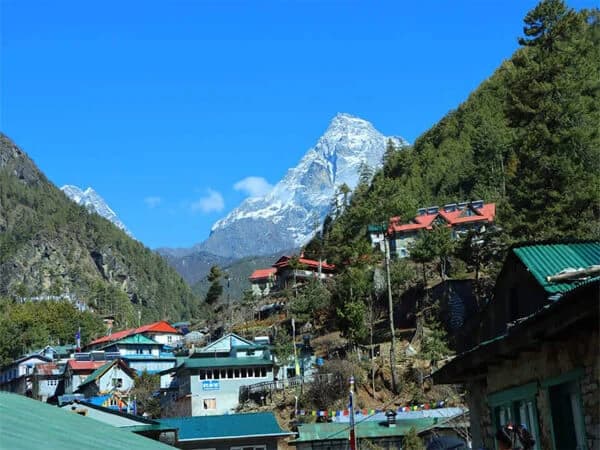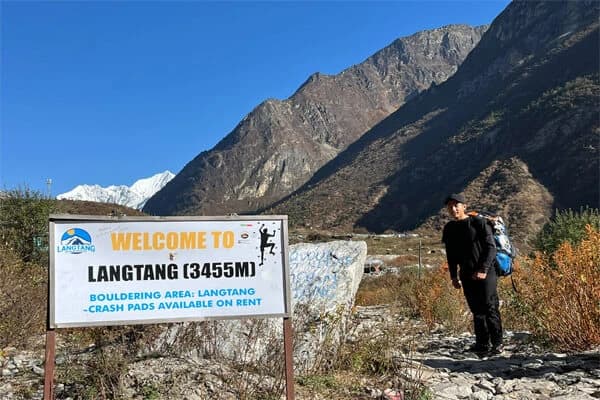Exploring the Everest Region and having the opportunity to witness Mount Everest up close is made possible by the Everest Base Camp Trek with Helicopter Return and the Everest Base Camp Helicopter Tour. To accommodate varying tastes and physical capacities, each choice presents a distinctive fusion of adventure and breathtaking Himalayan vistas.
Everest Base Camp Trek with Helicopter Return
The Everest Base Camp Trek with Helicopter Return combines the adventure trekking through iconic Sherpa villages and the luxury of a helicopter ride back to Kathmandu. It appeals to those who wish to complete the traditional trek but prefer a quicker and more comfortable return.
What to Expect
The trek begins with a scenic flight to Lukla, the gateway to the Everest region trek. Trekkers journey through Sherpa villages like Namche Bazaar and Tengboche, acclimatizing to high altitudes along the way. The sense of achievement upon reaching Everest Base Camp is unparalleled, and the helicopter ride back offers breathtaking aerial views of the Himalayas, providing a memorable and time-efficient conclusion to the trek.
Highlights of the Everest Base Camp Trek with Helicopter Return
- Scenic Flight to Lukla: Begin your journey with a picturesque flight to Lukla, where the adventure starts amid the vibrant streets of Kathmandu.
- Cultural Immersion: Experience the warmth of Sherpa culture as you hike through charming settlements like Tengboche, Dingboche, and Namche Bazaar.
- Reaching Everest Base Camp: Stand at the foot of the world’s highest peak, Mount Everest, after days of trekking through challenging terrains.
- Kala Patthar Sunrise: Ascend Kala Patthar for a breathtaking sunrise view of Everest and neighboring peaks like Ama Dablam and Lhotse.
- Helicopter Return: Enjoy a thrilling helicopter ride back to Kathmandu, offering spectacular views of the Himalayas.
- Luxurious Comfort: End the trek with a comfortable stay in opulent accommodations, reflecting on the majesty of the Everest region.
Best Time for Everest Base Camp Trek with Helicopter Return
The ideal time for this trek depends on the Himalayan seasons, each offering unique experiences:
- Everest Base Camp Trek with Helicopter Return in Spring Season (March to May): The best season for trekking, with longer daylight hours, pleasant weather, and blooming rhododendrons. Clear skies offer excellent views of Everest.
- Everest Base Camp Trek with Helicopter Return in Monsoon/Summer Season (June to August): Known for rain and slick trails, but with fewer crowds and lush landscapes. Perfect for those seeking solitude.
- Everest Base Camp Trek with Helicopter Return in Autumn Season (September to November): Another popular season, with clear skies and mild weather post-monsoon. Cultural festivals like Dashain and Tihar add to the experience.
- Everest Base Camp Trek with Helicopter Return in Winter Season (December to February): Cold and less crowded, with the potential for snowfall. Clear skies offer stunning views, but trekkers must be prepared for the cold.
Physical Requirements
This trek is demanding, requiring a high level of physical fitness and careful preparation. Trekkers must endure long days of walking on steep, rocky terrain, often at altitudes exceeding 5,000 meters. Acclimatization is crucial to prevent altitude sickness, and mental toughness is essential to persevere through challenging conditions.
Health and Safety
Health and safety are paramount on this trek due to its demanding nature and remote environment. Proper acclimatization, a thorough medical check-up, staying hydrated, and maintaining personal hygiene are critical. Employing experienced guides and carrying appropriate gear is essential for handling sudden weather changes and emergencies.
Considerations for the Everest Base Camp Trek with Helicopter Return
- Comprehensive Experience: A deep immersion into the heart of the Himalayas, covering iconic routes and landscapes.
- Time-Efficient Return: The helicopter return saves time and energy, making the trek accessible without the physical demand of a full descent.
- Aerial Views: Spectacular aerial views of the terrain covered, offering a unique perspective and excellent photography opportunities.
- Reduced Physical Strain: Less wear and tear on the body, particularly beneficial for those who find the long descent challenging.
- Higher Cost: The inclusion of a helicopter ride increases the cost, potentially making it out of budget for some.
- Weather Dependence: Helicopter flights are highly susceptible to weather conditions, leading to potential delays or cancellations.
- Limited Space for Gear: Weight and space limitations on the helicopter may restrict the amount of gear you can bring back.
- Environmental Impact: Helicopter flights contribute to noise pollution and have a higher carbon footprint.
Everest Base Camp Helicopter Tour
The Everest Base Camp Helicopter Tour offers a thrilling way to experience Everest without the physical demands of trekking. Ideal for those with time constraints or limited physical capabilities, this tour provides a comprehensive aerial view of the world's highest peaks.
The Flight
The helicopter tour begins early in the morning from Kathmandu, flying over diverse landscapes, including Sherpa villages and trekking trails. After a brief refueling stop in Lukla, the helicopter proceeds to Kala Patthar, offering the closest and most breathtaking views of Mount Everest. This brief but intense experience allows travelers to capture the majesty of Everest without the extended trek.
Highlights of the Everest Base Camp Helicopter Tour
- Stunning Aerial Views: Enjoy unparalleled views of Mount Everest and the surrounding Himalayas from the comfort of a helicopter.
- Landing at Kala Patthar: Experience the thrill of landing at Kala Patthar or Everest Base Camp, getting up close to the tallest peak on Earth.
- Quick and Convenient: Perfect for those with time or physical limitations, offering a comprehensive Everest experience in a short timeframe.
- Insightful Commentary: Knowledgeable pilots provide commentary on the mountains and significant locations, enriching the experience.
- Optional Luxury Add-Ons: Enhance the tour with an optional tea or breakfast at a hotel with panoramic views of the Everest range.
Best Time to the Everest Base Camp Helicopter Tour
The best times helicopter tour are during the pre-monsoon (March to May) and post-monsoon (September to November) seasons, when the skies are clear, and the weather is stable. These periods offer the best visibility and safety for the helicopter ride. Winter also provides clear skies, but the cold may be uncomfortable at high altitudes. The monsoon season is generally avoided due to unpredictable weather and poor visibility.
Considerations for the Everest Base Camp Helicopter Tour
- Weather Dependence: Clear skies are crucial for visibility and safety, making the tour highly weather-dependent.
- Altitude Precautions: Be aware of the risks of high altitude, including altitude sickness.
- Clothing and Equipment: Dress in layers with windproof jackets to combat the cold, especially at higher altitudes.
- Physical Condition: Although less physically demanding, passengers should be in good health to tolerate high altitudes.
- Cost & Budgeting: Helicopter tours can be expensive, so it's important to plan accordingly and confirm what is included in the tour fee.
- Permits and Licensing: Ensure all necessary permits are in place, as some landings may require special authorization.
- Insurance: Obtain appropriate travel insurance that covers high-altitude activities and helicopter rides.
- Environmental Impact: Consider the environmental impact of helicopter tours and choose operators that follow sustainable practices.
FAQs for the Everest Base Camp Trek with Helicopter Return vs. Everest Base Camp Helicopter Tour
What is the duration of the Everest Base Camp Trek with Helicopter Return compared to the Everest Base Camp Helicopter Tour?
The Everest Base Camp Trek with Helicopter Return typically lasts around 12-14 days, including acclimatization days and the trek itself. In contrast, the Everest Base Camp Helicopter Tour is a much shorter experience, taking only 4-5 hours, making it ideal for those with limited time.
Which option is more physically demanding?
The Everest Base Camp Trek with Helicopter Return is more physically demanding, requiring several days of trekking at high altitudes, which can be challenging. The Everest Base Camp Helicopter Tour, however, involves minimal physical exertion, as it primarily consists of a helicopter ride to and from Everest Base Camp.
How does the cost of the Everest Base Camp Trek with Helicopter Return compare to the Helicopter Tour?
The Everest Base Camp Trek with Helicopter Return is generally more expensive due to the extended duration, guide services, accommodation, and helicopter flight. The Everest Base Camp Helicopter Tour, while shorter, still commands a high price due to the helicopter service but may be more cost-effective if you’re looking for a shorter experience.
Which option is better for acclimatization and avoiding altitude sickness?
The Everest Base Camp Trek with Helicopter Return is better for acclimatization, as it includes gradual altitude gain and acclimatization days, reducing the risk of altitude sickness. The Helicopter Tour, though quicker, poses a higher risk of altitude-related issues as it involves rapid ascent to high altitudes without the time for acclimatization.
What kind of views and experiences can I expect from each option?
The Everest Base Camp Trek offers up-close views of the Himalayan landscapes, including forests, rivers, and traditional villages, along with personal interactions with local communities. The Helicopter Tour provides sweeping, panoramic views of the mountains, glaciers, and Everest itself from above, but with less personal interaction with the environment.
Which option should I choose if I have limited time?
If you have limited time, the Everest Base Camp Helicopter Tour is the better choice, as it allows you to experience Everest and its surroundings within a few hours. The trek with helicopter return is ideal if you have more time and wish to fully immerse yourself in the Himalayan trekking experience.
Is there a difference in the seasonality for both options?
Both options are best undertaken during the pre-monsoon (March to May) and post-monsoon (September to November) seasons for optimal weather and visibility. However, the Helicopter Tour might have more flexibility in timing as it’s less dependent on trekking conditions.
Conclusion: Everest Base Camp Trek with Helicopter Return vs. Everest Base Camp Helicopter Tour
Choosing between the Everest Base Camp Trek with Helicopter Return and the Everest Base Camp Helicopter Tour depends on the experience you seek. The trek with a helicopter return offers an immersive adventure, engaging with the landscape, culture, and physical challenge over several days, while the helicopter tour is perfect for those who want a quick yet comprehensive view of Everest without physical exertion. Both options provide unforgettable encounters with the majesty of Mount Everest, each in its unique way.

